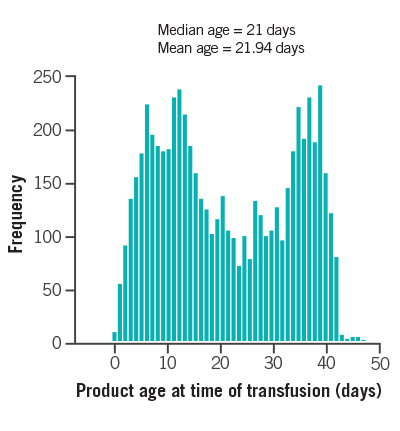Discover how O negative red cells are being used nationally within hospital and pathology settings.
The Blood Service has recently had findings from a research project published in Transfusion.* The study aimed to better understand how precious and versatile O negative red blood cells are being used nationally within hospital and pathology settings.
In recent years, demand for O negative red blood cell units in Australia has remained stable or increased slightly. However, the proportional demand has increased sharply. Only around 8 per cent of Australians have O negative blood, but in the first six months of 2016 orders of O negative red cells made up 15.7 per cent of all red cell orders — up from 11.2 per cent in 2010. This puts pressure on a small pool of donors that already donates at a higher rate than donors of other ABO types.
Although this proportional increase does reflect international trends, it’s still higher here than for the USA, Canada, Ireland, Israel, and the UK, where the average is 11.5 per cent of all orders**. This is also despite overall red cell demand in Australia decreasing 21 per cent since 2010.
One of the reasons why O negative red cells are in demand is because of their versatility: they can be given to any patient in an emergency without their blood type being known. However, without any notable increase in emergencies and with overall red cell demand dropping, we wanted to discover more about the reasons for O negative red cell demand, with the ultimate goal of working towards a sustainable supply in the future.
About the survey
We asked customers to report on their use and discards of O negative units for a five-week period in 2015. Of the 9,658 units sent to hospitals during this time, customers reported on the fate of 7,143 units, or 74 per cent of all issues.
We received responses from a good national representative group of hospitals of various sizes, types, and metropolitan and regional/rural locations.
What we found
Discards and expiries were higher
During the survey, 6,387 O negative units were transfused into an estimated total of 3,008 patients. 549 O negative units were discarded, translating to a 7.9 per cent discard rate, much higher than the average of 3.1 per cent rate for all groups in 2015/16. 64 per cent of all O negative discards were due to time expiry.
Two peaks in usage
Although the median product age at transfusion was 21 days, within this there were two clear usage peaks (shown on graph). The first is between 7 and 16 days and the second peak is at between 34 and 40 days, when units are approaching the 42-day expiry. The second peak suggests that they are being selected to prevent expiry.
Less than half are transfused to O negative patients
Surprisingly, only 47 per cent of the red cells for which the patient’s ABO group was provided in the returned survey (3,003 units) were transfused to O D negative patients. 24.5 per cent (1,565 units) were transfused to patients who were known to be group A, B or AB prior to commencing the transfusion, with 57.8 per cent of those (905 units) being transfused to D positive individuals.
One in 10 used when patient ABO group unknown
The survey showed that the patient’s ABO group was not known at the time of transfusion in only 615 cases, or 10.1 per cent of total returned surveys.
A quarter are transfused to avoid expiry
1,565 O negative units (24.5 per cent of the total transfused) were chosen for transfusion because they were close to expiry. Of these, 80.1 per cent were used in routine transfusions and only 13.6 per cent were used in urgent transfusions.
Of these particular units, 71.3 per cent were transfused into group O patients, with 72.2 per cent of these being O positive. Of the 28.3 per cent transfused into patients of other ABO groups, 72.4 per cent of these patients were D positive.
Slightly more men, slightly younger patients
Of the transfused units, 3,514 units (55 per cent) were transfused into males and 2,809 units (44 per cent) were transfused into females, with the remaining not specified. Median patient age was 67 years, but the survey did show a trend towards younger individuals receiving more of the urgent transfusions.
What we learned
As expected, O negative red cells are in high demand by all types of customers whether they are large or small, metropolitan or regional, public or private institutions.
We also found that not as many O negative red cells were being used in emergency situations or for phenotype matches as might be expected. Instead, many are transfused to prevent time expiry in situations where ABO identical units may have been more suitable.
Where to from here
The answers to the O negative supply challenge in Australia are not simple, and could include a varied combination of initiatives: re-evaluation of inventory holdings for transfusion laboratories; greater sharing and stock rotation between hospital sites; removing disincentives for customers to hold minor ABO groups; education on appropriate use of group compatible units and the challenges of supply; and potentially even differential pricing for red cells of different blood groups. The National Inventory Management Framework Steering Committee, which is chaired by the National Blood Authority and includes health professionals, Blood Service and government representatives, are currently considering these issues and will be making a recommendation to the Jurisdictional Blood Committee in the near future.
Whatever the resulting actions, it will be up to all of us in the blood sector — the Blood Service, pathology services, health professionals, hospitals and government — to work together to find solutions.
*‘A national review of the clinical use of group O D– red blood cell units.’ Transfusion, Hirani et al.
*‘Changes in blood center red blood cell distributions in the era of patient blood management: the trends for collection (TFC) study.’ Transfusion, 24 Aug 2016. http://www.ncbi.nlm.nih.gov/pubmed/27339776

